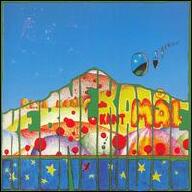The driving force in Kebnekaise was guitarist Kenny Håkansson. In the '60s, he and drummer Pelle Ekman played together in T-Bones and in a band that later changed its name to Baby Grand Mother. In 1969, Håkansson, Ekman, and bassist Bengt Linnarsson were recruited as the new backing for Hammond player Mecki Mark, becoming his Mecki Mark Men. In 1971, after a chaotic U.S. tour together with Sly and the Family Stone, Mark left and guitarist Rolf Scherrer was recruited. The new band took the name Kebnekaise after the highest mountain in Sweden, and started out as a mainly instrumental rock band in the tradition of Hendrix and Cream, releasing the debut album Resa Mot Okänt Mål in 1971. For the second album they recruited six new musicians: guitarists Glenngård and Böckler, percussionist Hassan, harmonica player Lindström, and drummer Netzler. Soon bassist Göran Lagerberg, who had played with Tages in the '60s, also joined the group. If the first album had been influenced by blues-rock, the harmonies had indeed lacked some blues. On the second, self-titled album, Kebnekaise followed this less-bluesy path into folk-rock, but very Scandinavian folk-rock: melodic and sentimental, mostly played in minor keys. And though Kebnekaise tried out a number of different styles, this was the style that would make them famous.
In between long tours, the group released their third album, Kebnekaise III, showing more jazz influences than earlier albums but also more African influences, introduced by percussionist Bah, an immigrant from Guinea-Bissau. The entire fourth album was dedicated to African music, but at its release, half of the group had left, leaving Kebnekaise as a five-man band. The following years this disintegration continued, both crew-wise and musically. Elefanten was released in 1977, but despite the title pointing toward Africa, the album was mainly a jazz-rock affair, with clear fusion tendencies. And the folk music, both African and Swedish, was almost gone. After this, Håkansson left the band to start a solo career, and with him most of the creativity seemed to have left as well. Together with drummer Pelle Holm and keyboard player Per Lejring, the remaining three members released Vi Drar Vidare in 1978, a symphonic rock album that failed to make much impact. The members started to look for other jobs and some time around that year, Kebnekaise ceased to exist. Glenngård released a few solo albums and worked as a session musician, with ABBA, for example. Bah formed the band the Happy Boys, also including Netzler, but soon moved to Finland. ~ Lars Lovén, Rovi
















